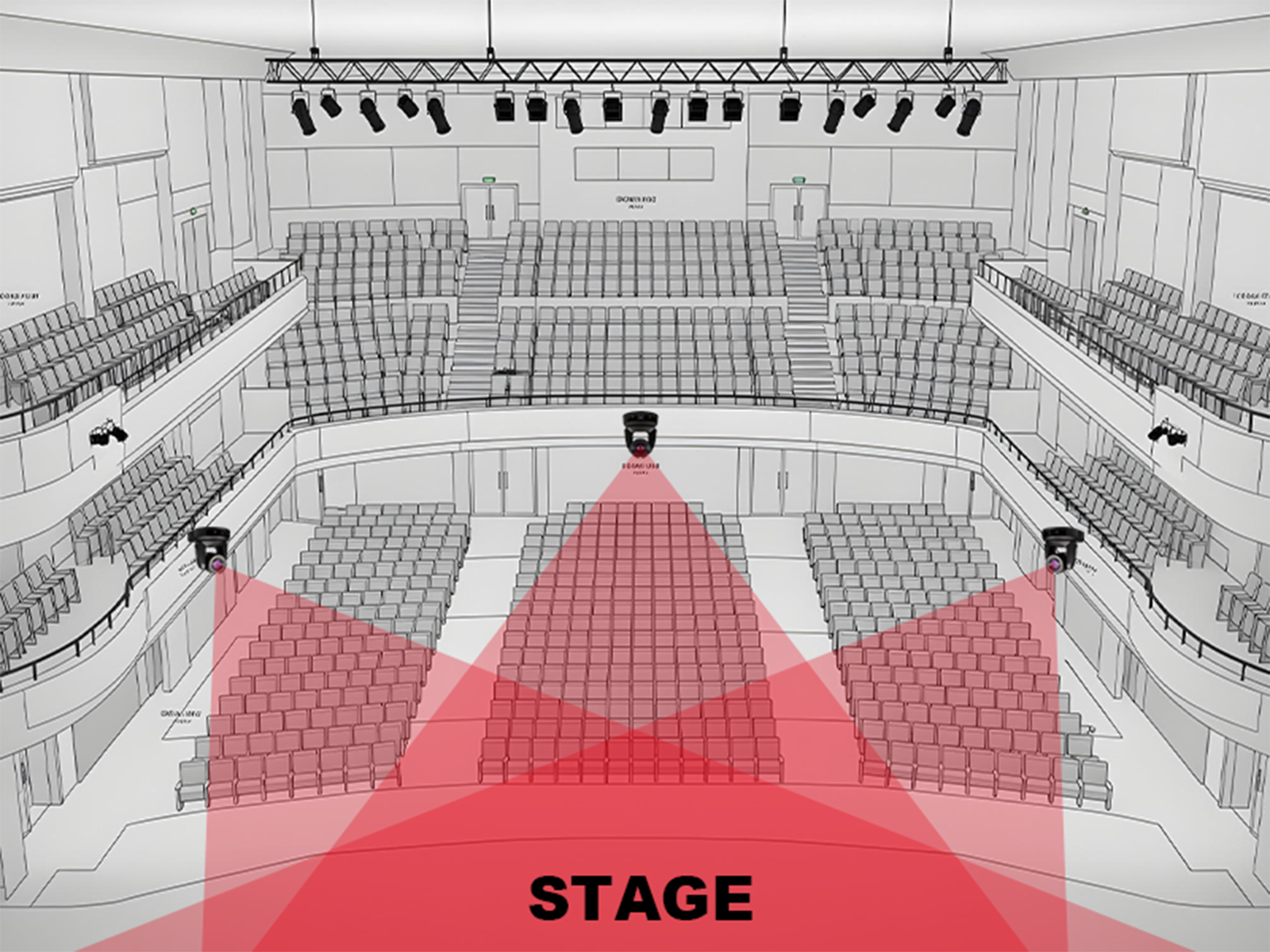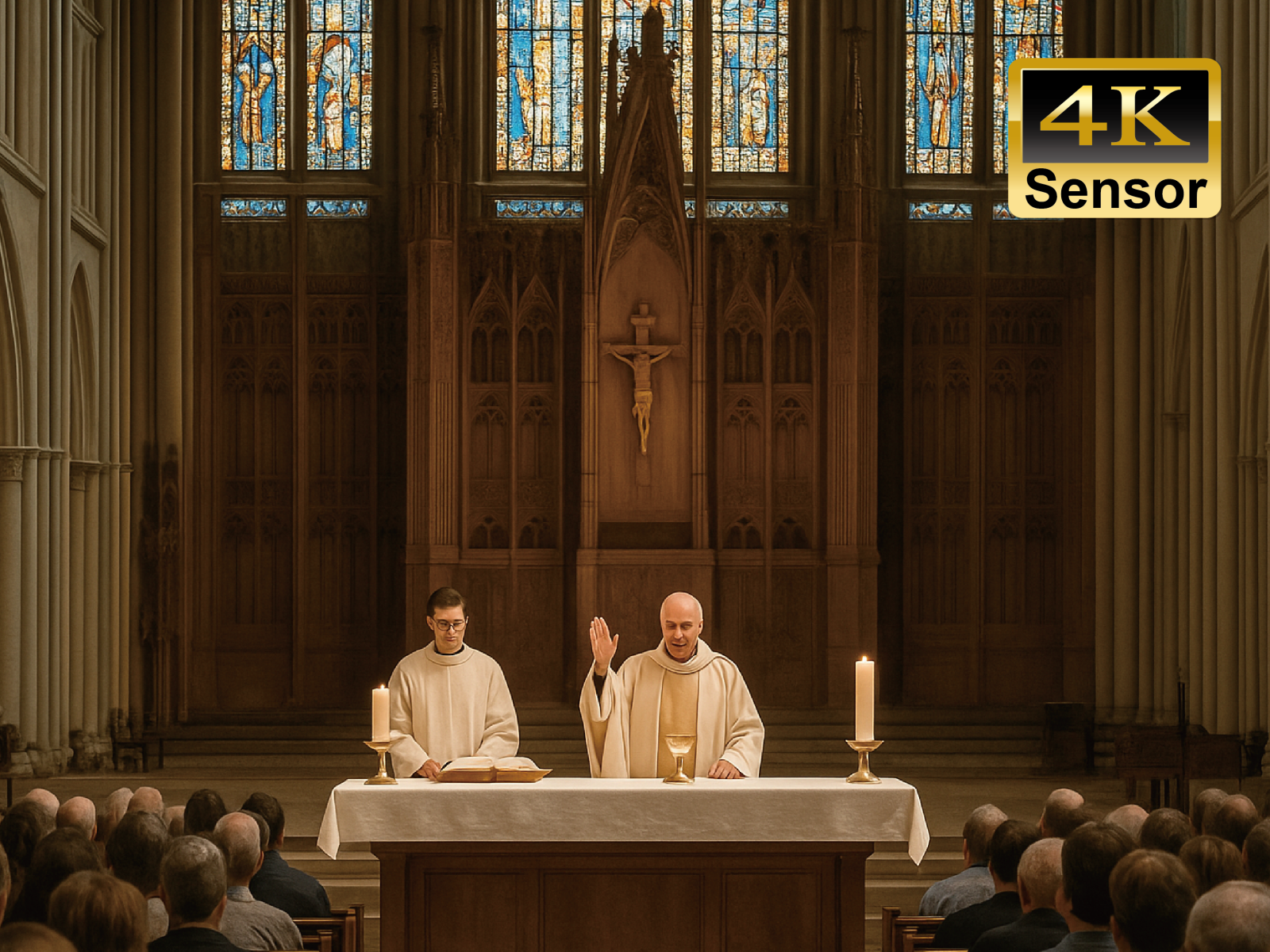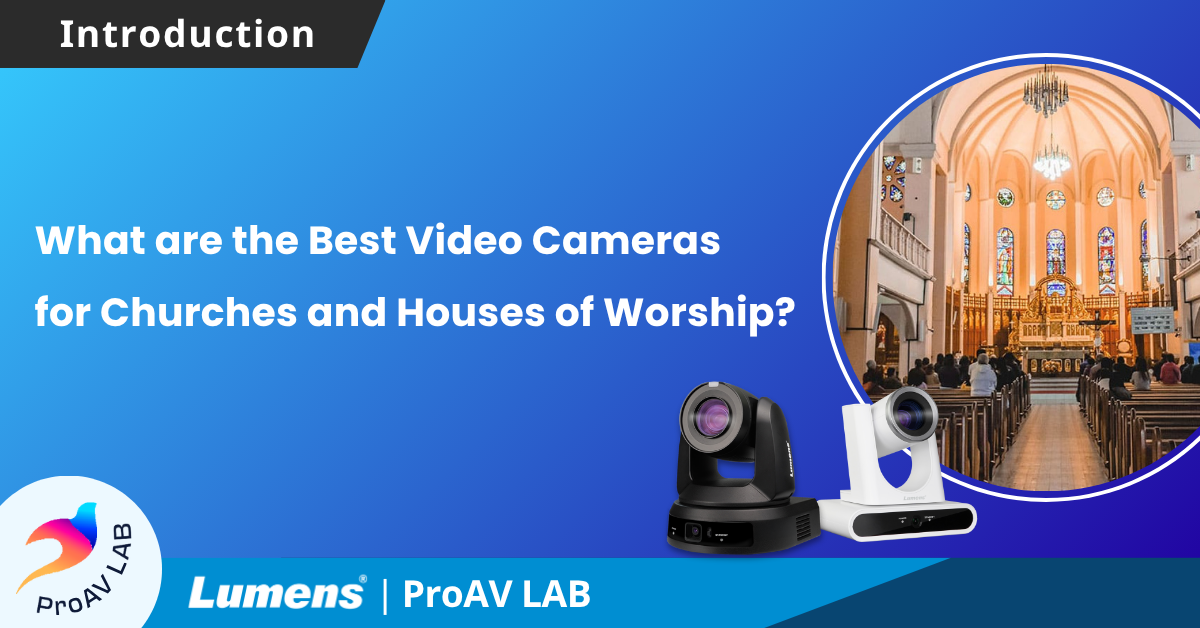What Are the Best Video Cameras for Churches and Houses of Worship?
Written by Kieron Seth, Product Marketing Director at Lumens
August 04, 2025 7657
- Is a broadcast camcorder still suitable for a house of worship?
- Is camera size important for houses of worship?
- What should I look for in a PTZ camera for a typical house of worship?
- What's the best budget option PTZ camera for a house of worship?
- Is 4K essential for Houses of Worship?
- Are AI-enabled cameras worth considering for churches?
- Is NDI HX worth considering for church production?
- Can NDI HX be used by small church production teams?
- How do I install PTZ cameras in a church?
- How do I get started in church production?
At the Capture Summit 2025, part of Church Facilities Expo, delegates heard about the massive changes taking place in video production. “Like church production teams, AV and IT teams have smaller teams than they did ten years ago" reported Tim Albright. One of the consequences of this has been a surge in popularity of unmanned automated cameras. For many volunteers working in church AV, automated PTZ cameras are new and unnerving. This guide is designed to de-mystify these robotic cameras and show you how they can transform the way you film your acts of worship.
▶ Is a broadcast camcorder still suitable for a house of worship?
In the largest venues where video will be produced for TV broadcast, many houses of worship still opt for studio cameras, traditional camcorders and fixed position cameras with (physically) long lenses. There is no question, that these can deliver world-beating results… but at quite a cost!
Each of these cameras needs a dedicated operator, a dedicated power supply, dedicated video cabling and an intercom system. This all adds up to a lot of time, cost and expertise. And the costs are ongoing, with the need for trained and experienced camera operators, technicians, sound engineers and vision mixers. The results are certainly worth it for the largest houses of worship and especially for those with a global television audience. For most organizations, however, simpler and more cost-effective approaches are called for and it’s no surprise that automated PTZ cameras are gaining ground.
▶ Is camera size important for houses of worship?
One of the issues with traditional cameras and camcorders is their size. Even new generation compact units need a large battery (or power supply) and long lens. Conversely, micro cameras (and webcams) are lightweight and easy to install discreetly, but they are typically built around a small sensor and have lenses that don’t have the ability to capture both a wide-angle view and to zoom in on a speaker at the front of the room.
PTZ cameras were designed for fly-on-the-wall documentaries like Big Brother. For these productions, the cameras had to deliver television-quality performance, have a flexible zoom lens and be small enough to install unobtrusively on a set. Small and lightweight, they hit the sweet spot between the camcorder and the micro camera and are therefore extremely popular in houses of worship.
In traditional cathedrals (often with poor lighting) or modern auditoria (with dynamic performance lighting), a heavier (6.6 lbs / 3 kg) large sensor PTZ model like the Lumens VC-A71P-HN is advised. These are often preferred in spaces with poor or difficult lighting conditions. In most spaces which are more evenly lit, a smaller PTZ unit such as the 30x zoom VC-TR61 (4.4 lbs / 2 kg) or the 12x zoom VC-TR30 (3.3 lbs / 1.5 kg) are very popular.

▶ What should I look for in a PTZ camera for a typical house of worship?
Today, many PTZ cameras have standardized around professional, high performance HD sensors (1/1.8” and 1/3”) and powerful optical zoom lenses. With a huge number of options on the market, it can be hard to choose between the various models.
So, let's go back to basics. Before considering the kit, we advise first creating a sketch of your building. Now add 2-3 camera positions and draw the angles that they need to shoot in order to film the main activities undertaken in the church. Be sure to add a camera that looks back towards the congregation, which is perfect for capturing communal worship and song.

With this sketch, you can now use the Lumens Capture Area Calculator to check which cameras will best suit your needs, based the range of their zoom lens. For example, you may wish to consider a pair of VC-TR60A cameras with their very wide maximum horizontal viewing angle of 81° to cover both the entirety of the stage and the congregation’s seating. This can combine with a pair of 20x zoom VC-TR40 cameras or 30x zoom VC-TR61 that can focus in on specific areas.
▶ What’s the best budget option PTZ camera for a house of worship?
We recommend one or two cameras for basic church installations. First is the VC-R31 12x zoom camera. It’s an HD camera that produces really lovely images, even in poorly lit spaces and it’s very easy to use. Simply angle the camera towards the most frequently used parts of the building and save those as preset positions using the remote control. Using the control, press buttons 1-4 to quickly switch the camera angle to capture the service.
The second choice is the VC-TR30, which gives users all the benefits of the VC-R31, but adds motion-tracking. With this enabled, the camera will identify the current presenter, then automatically focus and move to create a more dynamic production.
▶ What are the benefits of higher end PTZ cameras for houses of worship?
What does a bigger, more expensive camera give you?
- Larger sensor: a bigger camera sensor (1/1.8" or bigger) can capture more light, giving you better performance in lower light. It can also deliver better color accuracy, (with support for Rec.709 and BT2020) and lower noise in shadow areas.
- Higher resolution: 4K cameras are now readily available, delivering four times the resolution of HD video. This translates to sharper, more detailed pictures.
- Broadcast video outputs: top end cameras feature 3G-SDI, 6G-SDI and 12G-SDI BNC video ports that connect to multi-channel vision mixers and production equipment. Fast, reliable, high quality and durable, this is an excellent format that is used in TV production worldwide.
- Professional streaming formats: experienced users can take advantage of the NDI format, a superb, low latency IP standard. It simplifies video installations compared with HDMI and SDI alternatives, is extremely beneficial in multi-operator productions, and delivers TV-style results at a significantly lower cost than with traditional cabling.
- Advanced features such as genlock, ND filters and simultaneous 3G-SDI and 12G-SDI outputs are useful in very high-end production to ensure video synchronization, monitoring and image control.

▶ Is 4K essential for Houses of Worship?
For the majority of facilities, HD can produce outstanding video quality. A well-positioned HD camera filming a well-lit stage will outperform most 4K cameras positioned in an unlit church. Therefore, our recommendation is to consider the video resolution as one factor among many: lighting, sound and shooting angles are just as important.
This is especially true for services that are live streamed over the Internet. Most streaming platforms are optimized for HD (1080 0r 720) live delivery, and the typical audience member at home will be perfectly satisfied with a high-definition experience.
There are two main exceptions to this:
- Where a church has invested in large 4K format displays (50" and larger) or UltraHD projectors
- When a house of worship has invested in dedicated 4K broadcast and transmission equipment
In these circumstances, 4K cameras are certainly recommended.
▶ Are AI-enabled cameras worth considering for churches?
For many churches around the world, AI cameras have been negatively associated with recognizing the identity of individual congregants and there is considerable mistrust about their use as a result. At Lumens, we have implemented AI in many of our cameras, and they are able to perform human detection, but we have not enabled any kind of subject recognition or identification.
Lumens' motion tracking AI cameras have received multiple international awards for their ability to identify humans within a scene and to track them reliably and smoothly as they move across a stage. They make it simple to select the person for the camera to track, and to switch from one presenter to another with the simple click of a mouse.
AI, therefore, is a means of making a video production far more dynamic and fluid, without the need for a trained human operator. The feature can be turned on and off as required, enabling the camera to operate manually or autonomously.
Most motion tracking cameras, such as the VC-TR30 or VC-TR40 are very reliable over distances of up-to 8 metres. This is adequate for smaller facilities, or for installations where the camera can be positioned close to the stage. The VC-TR61 is designed for longer range tracking, more than doubling the maximum distance from lens to stage. This is great for bigger premises and even cathedrals where shooting distances can be much greater.
▶ Is NDI HX worth considering for church production?
NDI HX is an HD and 4K IP video streaming format designed for video production. With NDI HX, it’s possible to connect the camera with a single Ethernet cable which carries video, control and tally signals, plus power to the unit (when used with a suitable PoE switch). NDI HX, like any IP format, requires some basic knowledge of IT networking for the set-up, which can mean a short learning curve for teams used to SDI and HDMI cabling.
There are many benefits that make it well worth considering:
- Low cost: using affordable Cat6 cables and network switches is far more cost-effective than investing in a dedicated SDI video network.
- Scalable: IT networks are inherently scalable – it’s much easier and quicker to add equipment and users to a 1-gigabit Ethernet network.
- Creative: NDI is all about creative production. All users on the network have access to the video and audio streams, so you can dedicate different members of the team to each creative task, such as graphics, prompting, titles, switching and visual effects.
- Simplified: all NDI cameras, switchers, recorders, encoders etc are connected to a central network switch using Ethernet cabling. This makes it so much simpler to add devices to the network without having to consider complex system integration.
- Manageable: with all devices network-connected, the system administrator can monitor and control each device centrally, saving time and ensuring the optimal efficiency of the equipment.
For more details on NDI, click here to read our guide.
▶ Can NDI HX be used by small church production teams?
Unquestionably! In larger facilities, creative teams can employ multiple dedicated NDI tools, based around equipment such as Vizrt's Tricaster or Panasonic's Kairos platform.
In smaller facilities, there are superb options for single-operator NDI systems that balance creativity and productivity. For computer-savvy users willing and able to manage a computer workstation, OBS Broadcast and vMix are popular platforms. For most, however, a dedicated media processor such as the Lumens LC100N or LC300 are ideal all-in-one easy-to-use platforms that combine audio and video switching, multi-input recording and live streaming.
▶ How do I install PTZ cameras in a church?
Houses of worship are special buildings, especially historic sites in ancient cities. Unlike in video studios or modern office spaces, installers need to pay close attention to cabling and rigging, so that they make minimal impact on the fabric of the building. Again, the size and flexibility of or PTZ cameras come to the fore. Using the Lumens VC-TR40 as an example, let’s look at what makes this kind of unit so installer-friendly.
- Its small size (3.3 lbs / 1.4kg) means that it doesn’t need a heavy-duty rig bolted to the wall or ceiling. A lightweight wall-mount or even a clamp means quick installation and very little (or no) impact on the fabric of the building.
- Mount upright or inverted: select a position that gives you the best shooting angle but doesn't look unsightly.
- Single Ethernet cable connection for video transmission, power and control. Previous generation cameras needed an SDI cable, power adapter and a control cable which made installation complex and intrusive. The use of a single Ethernet cable (which could be an existing networking cable) is a win-win.
▶ How do I get started in church production?
Many of our partner organizations around the world have years of experience working with religious bodies to produce, record and stream services and acts of worship. Contact your local Lumens office for more details.
Click here Back to Top ↑

